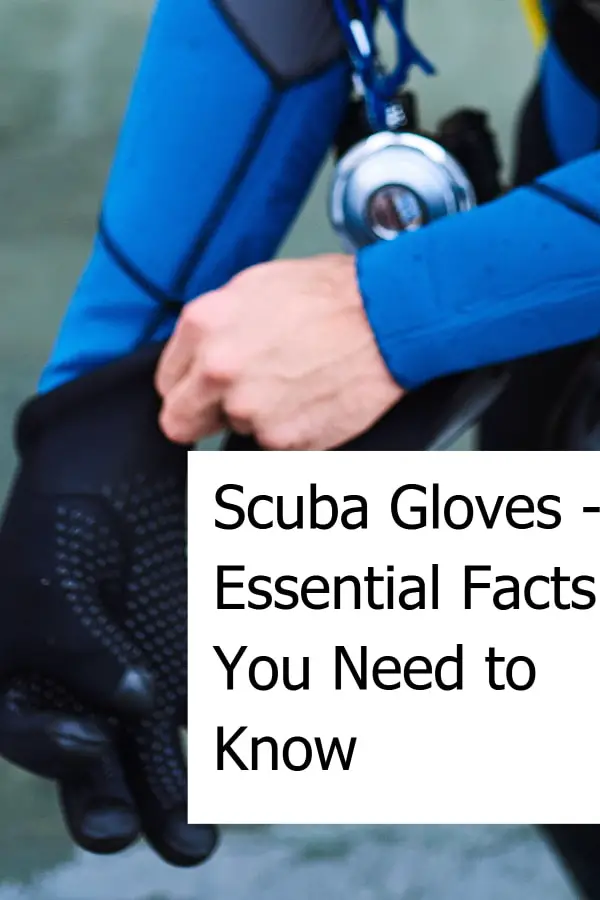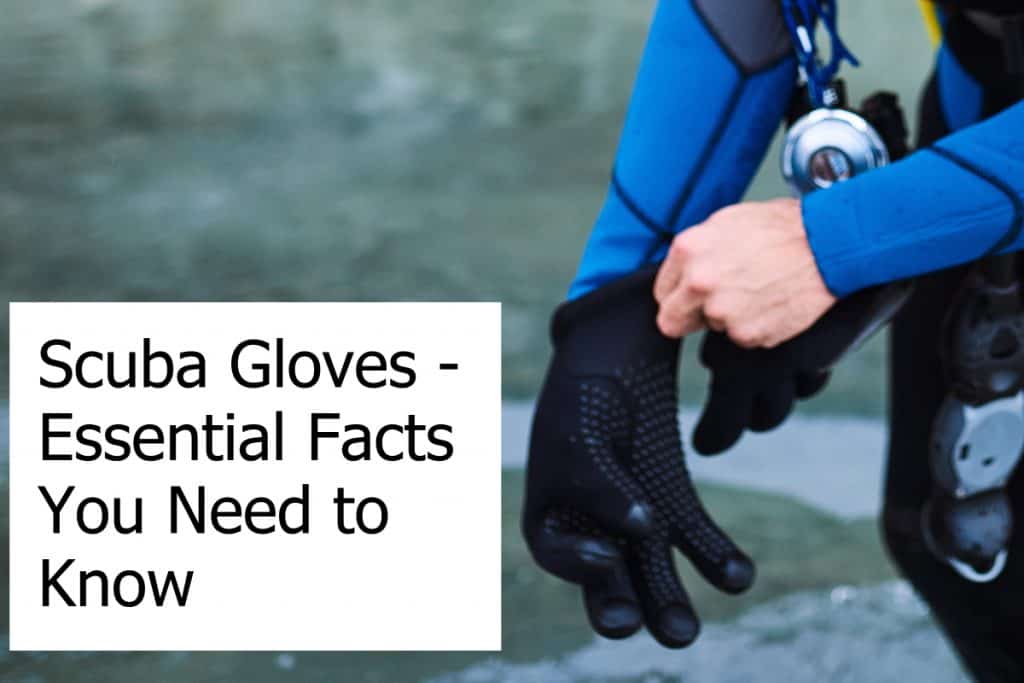Best Scuba Gloves – Essential Facts You Need to Know About Diving Gloves
Gloves for scuba diving have two important roles. First, they insulate your hands from the cold. Second, and in many cases more important is that they protect your hands while you are underwater.
We’ve collected the best overall scuba gloves as well as what features you have to look for when you want to buy new dive gloves in the sections below.
Best Dive Gloves
Let’s have a look at the best scuba gloves in the short reviews below.
Neo Sport Premium Five Finger Wetsuit Dive Gloves
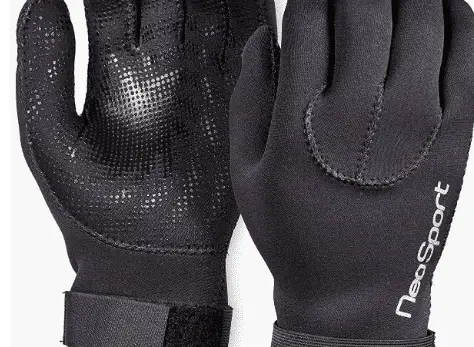
The Neo Sport Premium scuba gloves are 3 mm thick and made from Neoprene. The gloves feature a textured palm, and the fingers are designed to provide you with a better grip.
The seams are sewn and glued to allow for comfortable wear with the highest levels of protection. If you need an improved seal then you can use optional velcro fasteners.
The Neo Sport Premium gloves offer exceptional value for the money you pay!
Scubapro Everflex
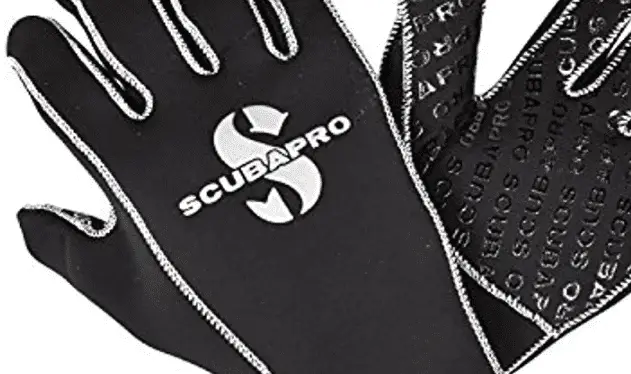
The Scubapro Everflex dive gloves are made from 3mm thick Neoprene and Nylon. They are very light and foldable, which makes them a great choice to keep stuffed into a pocket of your BCD as a pair of backup scuba gloves.
The gloves feature glued and sewn seams. They are full-finger gloves and have a textured palm to provide additional grip.
The outer layer is made to dry quickly, while the inside is made with a smooth finish. This helps tremendously when you don or doff the gloves. The rolled cuff provides a tight and comfortable seal to prevent cold water from entering.
Tusa Tropical
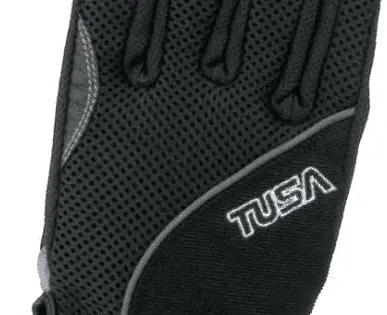
The Tusa Tropical are, in our opinion, the best dive gloves for warm water. They provide no insulation and are made from poly-mesh and poly-vinyl material.
As they do not have any insulation, they are easy to travel with. The palms are textured and provide added grip when diving when you want to grasp or need to adjust your gear.
The seams on the Tusa tropical gloves are sewn. The wrist closure consists of a hook and loop wrist strap that is easy to use.
Cressi High Stretch
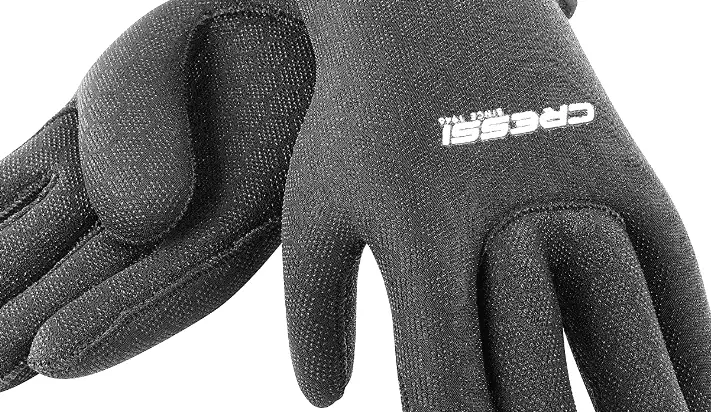
The Cressi High Stretch gloves are 2.5 mm thick, making them a good fit for warm and moderately warm waters. You can also get them in 3.5 mm and 5 mm thickness, making them one of the best cold-water scuba gloves available today.
They are a five-finger design and are made from high-stretch Neoprene. Cressi even designed them to be, by default, in a hand position that feels natural.
Cressi used Metallite as the material to make donning and doffing super-easy. The exterior non-slip finish gives you a stable and firm grip to make holding or adjusting your dive gear underwater easy.
Aqua Lung Thermocline
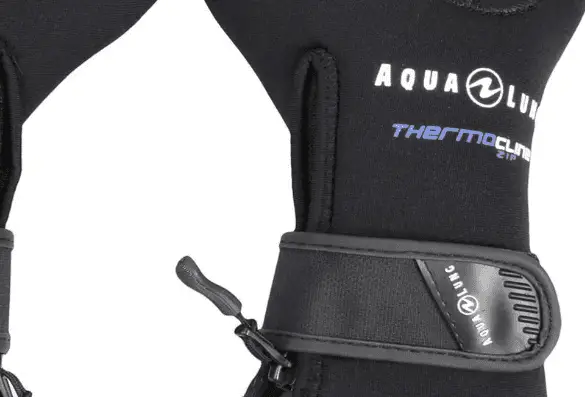
The Aqua Lung Thermocline is a pair of 5 mm thick Neoprene scuba diving gloves. As you can see from their thickness, these are dive gloves for medium-cold water.
They are very comfortable to wear and pretty easy to don and doff. Aqua Lung designed these gloves with glued and blind-stitched seams.
The Aqua Lung Thermocline has a textured palm for improved grip. It’s a five-finger design that is very comfortable to wear.
The gloves close with a combination of an easy-to-grasp zipper, a gusseted wrist, and a hook and loop wrist strap. This design tremendously reduces the amount of water entering into the gloves.
Bare Three Finger Mitt
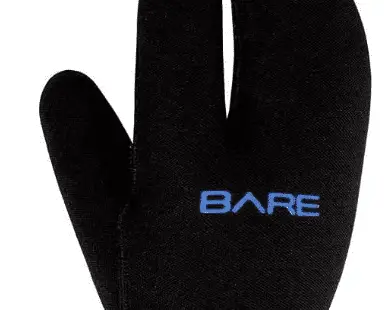
The Bare Three-Finger Mitt is, at first glance, a strange-looking design. The mitt has three fingers instead of five in order to keep your fingers warmer in cold water.
The scuba mitt is made from 7 mm thick Neoprene. This makes it the scuba mitt of choice for cold water dives.
The seams are double glued for comfort and tightness. It also helps to reduce the amount of water entering the gloves. The dive mitt has a textured palm for added grip when handling and adjusting your dive equipment underwater. The forearm cuff is gauntlet-style, which makes it easy to don and doff. It also adds additional thermal protection around the wrist seal of your wetsuit.
Mares Flexa Classic
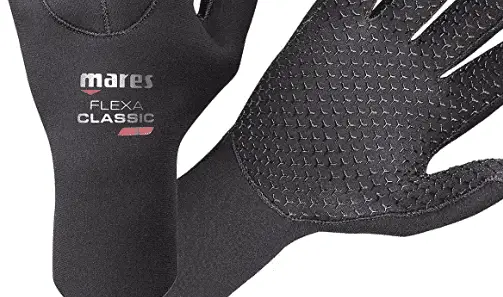
The Mares Flexa Classic dive gloves are made from 3 mm thick Neoprene. They are great warm-water scuba gloves with a five-finger design.
They are thick enough to keep your hands and fingers warm in moderately warm water. The 3 mm Neoprene is also suitable to provide you protection from the elements during your dives.
The double-coated Neoprene features a double glued and blind stitched construction. In combination with the preformed wrist shape, the entry of water is reduced. Yet, they are still flexible and comfortable to use. Mares also added a rubber layer over your palms for improved grip.
Scubapro Easy Don
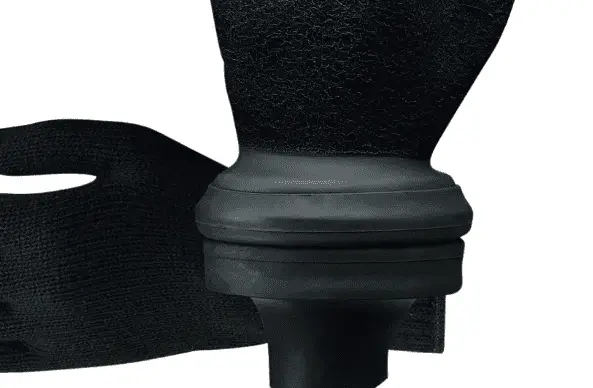
The Scubapro Easy Don dive gloves are made for cold water diving in combination with dry suits. They are made from vulcanized latex and are completely waterproof.
The gloves themselves do not help much with keeping your fingers and hands warm. Scubapro achieves thermal protection through an insulating layer that you find on the inside of the Easy Don gloves.
They are designed with anatomically cut and bent fingers in a five-finger layout. The dry wrist seal ensures that no water enters the inside of the gloves.
These are, without a doubt, some of the best scuba gloves for cold water you can find. Keep in mind that the added thickness and multiple layers do negatively impact your ability to grip and adjust your gear.
Why do you need Scuba Gloves?
There are really two main reasons why you need to dive with gloves. These are insulation and protection of your fingers and hands. Let’s have a closer look at each of these reasons.
Insulation
Diving in any temperature below your body temperature will result in warmth being sucked out of your body from the surrounding water. When was the last time you dived in 97 degrees water? Right, you didn’t.
To compensate for that loss we require some sort of insulation. Otherwise, the dive will eventually end up unpleasant due to getting cold.
This will affect some more than others but there are certainly enough people that start getting cold at their hands pretty quick. Even diving gloves as thin as 3 mm will keep your hands noticeably warmer and make the dive a better experience.
For cold water diving it’s essential to wear scuba gloves to keep your hands warm and useful. Many of the newer designs keep your hands as warm as old gloves that were much thicker. That is due to improved technology with regards to the Neoprene and other materials used, but also due to different manufacturing capabilities.
Look at how these gloves nowadays are glued and stitched. Some are glued multiple times and are blind stitched so they ‘fit like a glove’! This improves the comfort when you wear them as there’s less rubbing and chaffing. They also keep your fingers and hands warmer with thinner Neoprene.

If you haven’t tried dive gloves for a while then have a look at some of the current models. Many are seamless with no stitched seams now which makes them a lot more comfortable to wear. There are no more scratching seams.
Another advantage of these designs is also that they are not allowing that much water to exchange between the glove and the surrounding water. This results in you being able to wear a thinner glove that keeps your hands as warm as thick dive gloves did a few years back!
Protection
During a dive, your hands can be used quite a bit to look at things and touch your sights. That’s not so true if you’re staying above a coral reef but if you, for example, explore a wreck you will use your hands to touch and feel.
Many items underwater have sharp edges. In addition, quite a few living creatures have stingers, teeth, etc. Scuba diving gloves can offer a great protection against all of these possible harmful situations.
A dive won’t be pleasant if you get stung or scrape your hand or fingers. A simple dive glove that’s designed to protect your hands can make a difference whether you have to call a dive or not.
Most of these protective dive gloves are only 1 or 2 mm thick which makes them very comfortable to wear. Due to them being that thin, they do not offer a lot of thermal protection and insulation.
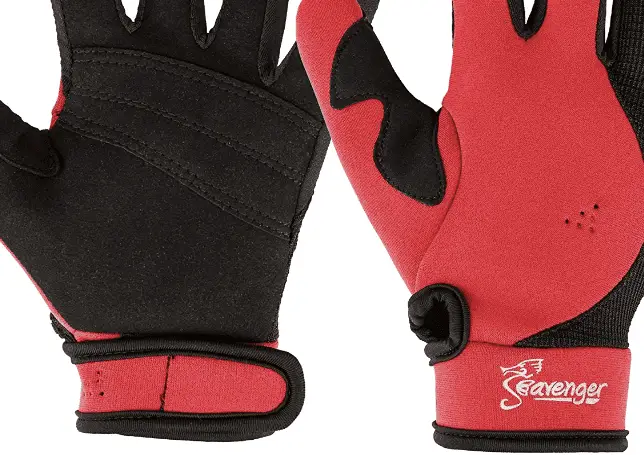
Protective gloves won’t help much with keeping your hands warm. It’s the job of scuba diving gloves to keep your hands safe from scratches, cuts, and stings in warm water.
These types of diving gloves offer reinforced areas to protect your fingers and palms. The materials used for dive gloves in those areas will also allow for a good grip.
The rest of the glove is mostly just simple high-stretch neoprene to offer protection and a little bit of insulation. They can provide a reasonable balance between protection and thermal insulation.
How to find the Best Scuba Gloves for your Diving
In the following sections, we are providing you with detailed information on what features you should consider when you are looking to buy new diving gloves.
Material Choices
Scuba diving gloves come in a variety of different materials. Not all dive gloves are made to keep your fingers and hands warm. Depending on why you need gloves, you can pick the material accordingly.
Neoprene Scuba Diving Gloves
The most common diving gloves material is Neoprene. Similar to wetsuits, water can penetrate and builds an insulating layer around your skin. This layer will keep your hands and fingers warm.
Neoprene is flexible and durable on top of its insulating features. It is overall rigid to protect your hands and fingers to avoid cuts from sharp edges. Neoprene is an excellent choice for your everyday dive glove.
The colder the environment gets, the thicker your neoprene glove needs to be. Eventually, you run into issues where the material is getting thick and bulky, and you can’t really use your hands that well. Even simple things like pressing the buttons on your dive computer can become quite hard when you wear thick neoprene scuba gloves.
Yet, Neoprene is certainly not the only material choice you have. Many modern gloves are constructed using a variety of materials. Neoprene has great features for diving but is not as tear-resistant as some divers require it to be. You can find a number of scuba gloves that have Kevlar included to make the gloves more resistant against cuts and tears.
Kevlar Dive Gloves
Kevlar implements help to protect your fingers and palms underwater from piercings and cuts. There is a reason why Kevlar is the material of choice for bulletproof vests as it is one of the most robust materials available.
Gloves for Drysuits
When diving in extremely cold water with a drysuit, you also have to have gloves that match. Neoprene gloves will not provide enough thermal insulation and protection in this case. Your fingers and hands will become numb, which is not only uncomfortable but can end up being dangerous.
If you dive with a dry suit, then you need to get dry gloves. These are made from the same waterproof material as a dry suit. They tighten around your wrist to seal the gloves against the suit. You can wear regular dive gloves underneath the dry gloves for increased warmth.
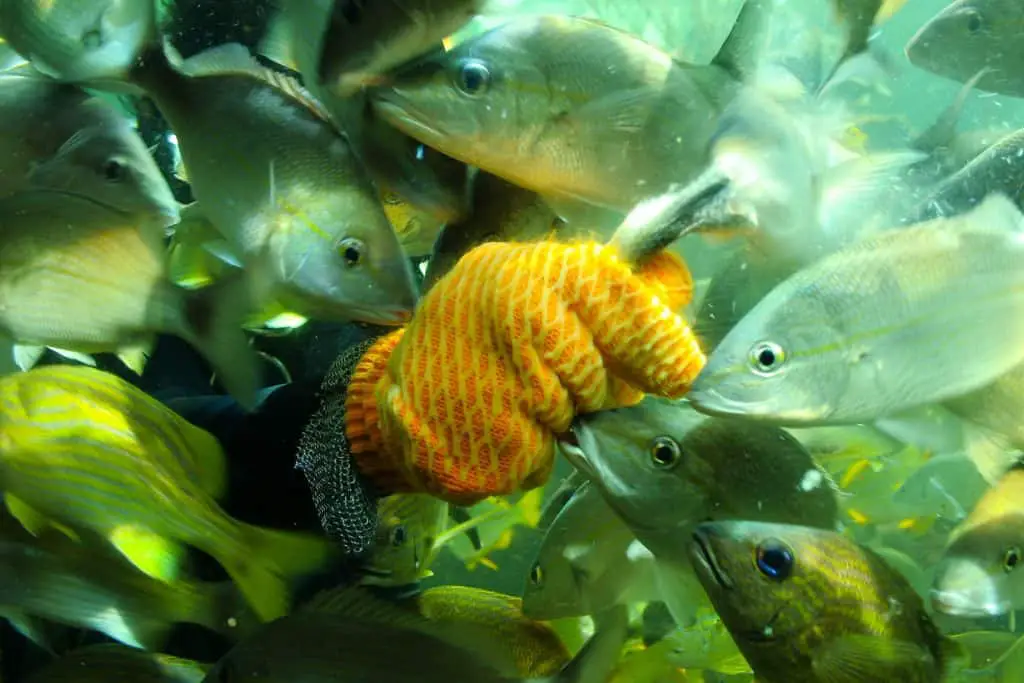
Material Thickness
As mentioned before, Neoprene gloves come in different thicknesses to provide more thermal protection in cold water. As to be expected, the colder the water you want to dive in, the thicker the material needs to be.
Yet, while a thicker glove will keep your fingers and hands warmer, it also will get bulkier and harder to grab things or use equipment. Most recreational divers will typically dive in warmer water and therefore do not require thick gloves. However, you can certainly dive in tropical waters with thicker gloves if you only have a single pair.
In warm water, you can typically get away with gloves that have a thickness of 1.5mm. If the water is not tropical yet still warm, then 2 to 3 mm should be sufficient. In colder environments, you want to pick gloves ranging between 3mm and 7 mm in thickness.
The following table provides you with the thickness levels to consider:
| Temperature Range | Thickness |
|---|---|
| Below 45 degrees F | 7mm |
| Between 46 and 61 degrees F | 5 mm – 7 mm |
| Between 61 and 75 degrees F | 1 mm – 3 mm |
| Above 75 degrees F | no gloves or up to 1 mm |
Sealing Mechanism
After deciding on the material and thickness, next up is the mechanism for sealing and securing the gloves. This will determine how easy the gloves come on and off but also how securely they are around your wrists while you dive. Lastly, a tight seal will usually help with better cold-water capabilities compared to a loose seal.
The simplest gloves don’t have any specific closures and seals. You simply put the gloves on as you would do with winter gloves. As you can imagine, water will simply go in and out as if you were not wearing a glove at all. This works well in warmer water but has your hands and fingers freezing very quickly in cold environments!
The most common closer is a simple closure system with an adjustable Velcro strap. It’s easy to open and close on land or even underwater.
Another mechanism that you often find is a high-quality zipper. They often come with an oversized pulling part so you can don and doff the gloves easily while diving.
Semi-dry and dry cuffs help to keep your hands dry. They can, unfortunately, be a pain to slide in or out. In some cases you might even need help to don and doff them.
Finger Layout
The design with five individual fingers is the most common layout you can find. The five-finger scuba gloves provide a tight fit with great mobility and grip.
These gloves work best in temperate environments. Once it gets really cold, then your fingers also turn cold pretty fast. That’s the same as if on land where gloves with fingers do not keep your hands and fingers warm when it’s freezing cold.
For cold-water dives, you should consider using mitten-shaped scuba gloves. Four fingers are kept in one single space, and the thumb is separated. You can grab with these dive gloves, but you don’t have good control or fine motor abilities.
Therefore, when you have to handle gear like dive computers or a camera, these mittens are not working well.
For diving in warm and tropical waters, you can also find gloves with open finger designs. The top part of your fingers is outside of the gloves. This design gives you the best fine motor abilities as you touch directly with your fingers. The glove portion keeps your hand and palms safe.
Sizing
Any diving gear has to be sized to fit correctly. This is also true for your scuba diving gloves.
Gloves that are too small will make you feel uncomfortable underwater. The mobility of your fingers will be restricted, and your blood flow into your hand and fingers can be impacted. During a longer dive in such ill-fitting gloves, you might experience numbness in your hands and fingers.
If the gloves are too large, then you risk that water can penetrate when there shouldn’t. This can lead to loss of heat in cold environments.
In addition, you might accidentally slip out of oversized gloves. As your movements lack precision, you can also have difficulty handling scuba gear like dive computers or adjusting your regulator.
The best fit is if your scuba gloves fit tight while still being comfortable.
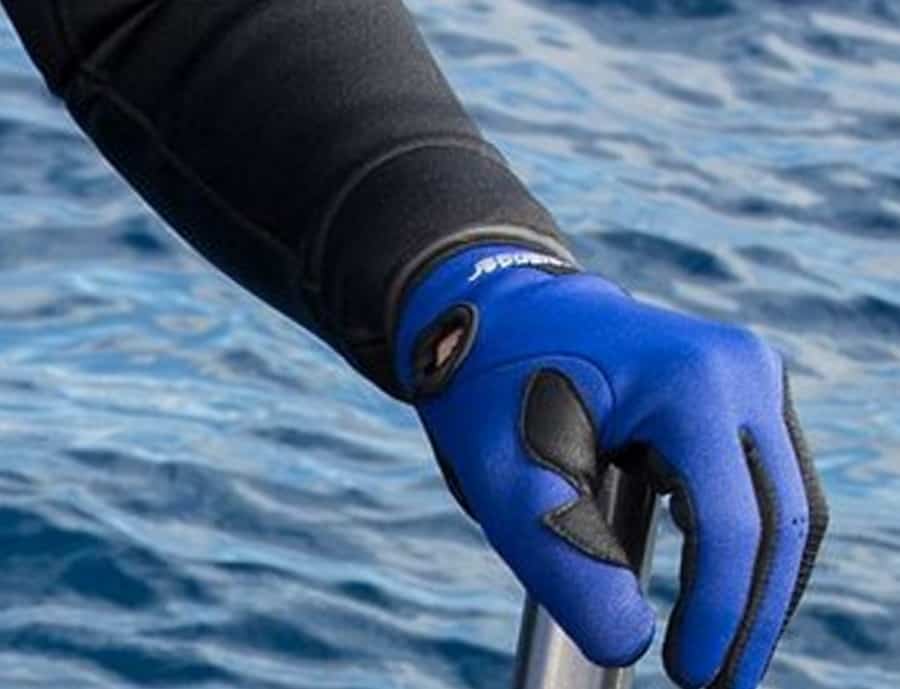
Keeping your Gloves clean
To keep your gloves clean, you simply follow your usual cleaning pattern for your other dive gear. The first step is to rinse the gloves with fresh water after each dive. This will wash away any saltwater or dirt residue.
It’s a good idea to use soap that you can use for the materials of your choice regularly to remove all remains of your dive surroundings. Make sure that you also thoroughly rinse the inside of your gloves.
After rinsing your dive gloves with clean freshwater, you have to make sure to dry them completely. Keep them in a dry place that is kept warm and ventilated. This will allow your gloves to dry quickly. Do not let your gear dry in direct sunlight. The UV rays can deteriorate the material and shorten the lifespan of your equipment.
